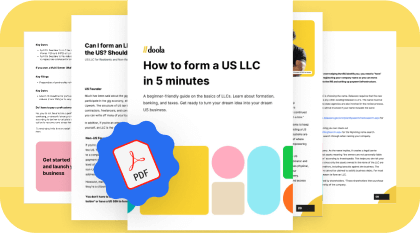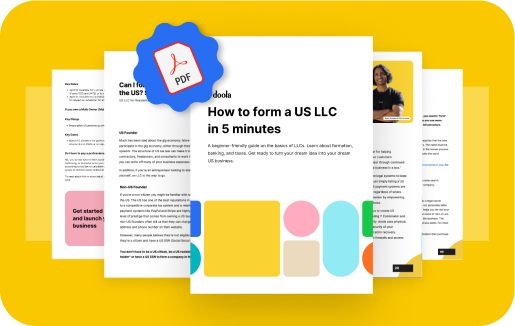Language:
How to Start an Import Export Business

Embarking on an import-export business venture can open up a world of opportunities for entrepreneurs seeking to tap into the global market.
This exciting and profitable field allows you to connect with suppliers and buyers across borders, fostering international trade and expanding your business horizons.
In this guide, we’ll walk you through the essential steps to launch your import-export business, from conducting market research and selecting a product to navigating regulations and building a reliable network.
So if you’re ready, let’s dig into how to start an import-export business.
Why Start an Import Export Business
The import-export industry thrives on the exchange of goods and services across international borders and accommodates companies of all sizes.
Within this industry, there are various types of import-export businesses, each with distinct characteristics and needs.
One of the main benefits of starting an import-export business is the accessibility to the global market. By distributing goods all across the world, the potential for profitability and growth can be exponential.
However, this market can be over-saturated and highly competitive. Not to mention, some countries still struggle with combating drug-related violence in this field.
As an entrepreneur, you should carefully weigh the benefits and challenges of the import-export business to decide which best suits your goals.
Types of Import Export Businesses
The import-export industry has experienced a significant surge in demand as globalization continues to break down international trade barriers.
As a result, businesses of all sizes are taking advantage of this opportunity to expand their reach and profits by trading goods and services across borders.
Here are the main types of import-export services.
Import Export Merchants
Import-export merchants are businesses that buy and sell goods internationally, acting as intermediaries between buyers and sellers in different countries.
As middlemen, import-export merchants purchase products from manufacturers or suppliers in one country and then sell them to buyers or distributors in another country for a profit.
They are not involved in the production of goods but rather focus on facilitating transactions between parties located in different parts of the world.
Export Trading Company (ETC)
An export trading company (ETC) is a type of import-export business that specializes in exporting goods and services from one country to another.
ETCs work with domestic manufacturers to help them find foreign buyers and sell their products in international markets.
In addition to acting as intermediaries between buyers and sellers, ETCs often provide other services such as market research, financing, and logistics support to facilitate the export process.
Export Management Company (EMC)
An export management company (EMC) assists domestic manufacturers in exporting their products to foreign markets.
EMCs work as agents on behalf of the manufacturers and are responsible for overseeing the entire export process — including marketing, distribution, logistics, and payment collection.
They typically specialize in one or more industries, such as agriculture, electronics, or textiles, and have extensive knowledge of the international market for those products.
11 Steps to Starting an Import Export Business
An import-export business can offer entrepreneurs a fulfilling opportunity to extend their reach and enhance profits by exchanging products and services globally.
To launch a prosperous import-export enterprise, meticulous planning and implementation are essential.
In the following sections, we present 11 critical steps entrepreneurs must undertake when initiating an import-export venture.
Adhering to these steps will enable entrepreneurs to create a robust groundwork for a flourishing import-export business.
1. Identify the Goods You Want to Import/Export
Initiating an import-export business begins with pinpointing the products or services you plan to exchange.
This entails investigating various goods and sectors to identify those with high demand in global markets and assessing their viability for import or export.
Crucial factors to consider include market trends, regulations, tariffs, shipping expenses, and competitors when choosing a product for import or export.
It’s also vital to recognize potential suppliers and buyers for your selected product to confirm the existence of a feasible market.
2. Source Suppliers
After determining the goods or services to import or export, the next step is to find suppliers capable of providing the products.
This process involves researching and locating potential suppliers in the country or countries where the products originate.
Utilize online directories, trade shows, and industry associations to discover suppliers — and assess them based on factors like quality, dependability, and pricing.
Fostering a strong relationship with your suppliers is vital to ensure receiving high-quality products and punctual deliveries.
3. Explore Shipping Options
The third step in starting an import-export business is to explore shipping options.
You can choose from various shipping options such as air, sea, or land transport.
Your choice will also depend on the nature of the products, the distance between the two countries, and your budget. It’s additionally important to consider factors such as the cost and efficiency of your operations.
4. Develop a Business Plan
Creating a business plan is vital when starting an import-export venture.
This comprehensive document outlines the business’s objectives, strategies, and financial projections — serving as a roadmap while highlighting potential challenges and opportunities.
Moreover, a well-crafted plan can assist in securing financing, attracting investors, and conveying the vision to potential partners and staff.
Below are the key points for crafting a business plan.
Target Customers
You can’t have a business without a loyal customer base. Here are some steps to identify your potential customers:
- Analyze market trends to determine which products are in demand and identify potential customers
- Research your competition and identify their target markets
- Study demographics, such as age, gender, income, and lifestyle, to understand the needs and preferences of potential customers
- Conduct surveys and focus groups to gather feedback from potential customers
- Use social media platforms to reach out to potential customers and gather data on their interests and preferences
Overall, understanding the target market is essential to developing effective marketing strategies and ensuring the success of your import-export business.
Projected Costs
Starting an import-export business involves various costs, including one-time expenses and ongoing operational costs. Here are some possible costs to consider when projecting the total cost of starting an import-export business:
- Initial expenses such as business registration, permits, and licensing fees
- Costs related to sourcing suppliers and negotiating contracts, such as travel expenses and legal fees
- Shipping and logistics costs, such as transportation fees, insurance, and customs duties
- Operational costs such as office rent, marketing expenses, and hiring employees
- Miscellaneous expenses such as website development, software subscriptions, and equipment purchases
Logistics and Distribution
Logistics and distribution are critical components of the import-export business, as they ensure the timely and efficient delivery of products to customers.
This process involves managing the flow of goods from supplier to buyer, including transportation, warehousing, and inventory management. Import-export companies must have a reliable logistics and distribution network to ensure their products are delivered on time and in good condition.
Through effective logistics and distribution management, import and export companies can build a reputation for reliability and customer satisfaction, which is essential for long-term success in this industry.
Pricing Model
Import-export businesses must consider various factors when developing a pricing model, including the cost of production, transportation, customs duties, and taxes.
It’s important to determine a fair and competitive price that considers the value of the product, the target market, and the competition.
Many import-export businesses use a cost-plus pricing model, which adds a markup to the cost of the product to determine the selling price.
Others may use a value-based pricing model, which considers the perceived value of the product to the customer.
Name of Business
Choosing a unique name for your import-export business can help establish your brand identity and gain recognition in the marketplace.
A business name should be memorable, easy to pronounce, and reflective of your products or services.
It should also be distinguishable from other businesses in the same industry to avoid confusion and legal issues.
A unique and memorable business name can help you establish a strong online presence and build your brand equity.
5. Choose Your Business Structure
In this step, we’ll review the main types of business structures. The structure you choose will determine the legal and financial obligations of your business, as well as your tax liabilities and personal assets.
By understanding the advantages and disadvantages of each structure and choosing the right one for your business, you can ensure that you comply with legal and tax requirements.
Sole Proprietorship
A sole proprietorship is a simple business structure with an individual owning and operating it.
Advantages: Easy setup and maintenance, full control, flexibility, and retaining all profits.
Disadvantages: Unlimited personal liability, raising capital can be difficult, termination upon the owner’s retirement or death, and limited credibility.
A suitable option for entrepreneurs who want full control and have limited personal assets at risk.
General Partnership
A general partnership involves two or more people owning and operating a business.
Advantages: Simple setup, shared decision-making, pooled resources, and tax benefits.
Disadvantages: Unlimited personal liability, potential disputes, joint liability for partner actions, and limited capital raising opportunities.
It’s an ideal option for entrepreneurs wanting shared responsibilities but requires trust and communication among partners.
Limited Partnership
A limited partnership consists of at least one general partner and one limited partner.
A limited partner is typically the main investor of the business with minimal management. The general partner is more hands-on with the business and oversees the company’s operations.
Advantages: Limited liability for limited partners, management flexibility, and the ability to raise capital without giving up control.
Disadvantages: Unlimited liability for general partners, potential disputes, complex legal requirements, and limited capital raising opportunities compared to other structures.
This option is suitable for entrepreneurs seeking investors while retaining control.
Limited Liability Company (LLC)
An LLC combines partnership flexibility with corporation liability protection.
Advantages: Limited personal liability, management flexibility, pass-through taxation, and fewer regulatory requirements.
Disadvantages: Complexity in setup and maintenance, limited capital raising opportunities, potential personal liability limitations, and higher operating costs.
An LLC is ideal for entrepreneurs wanting flexibility and limited liability protection but may not suit businesses needing significant capital or facing high legal risks.
Corporation
A corporation is a separate legal entity owned by shareholders.
Advantages: Limited personal liability, easier capital access, perpetual existence, and potential tax benefits.
Disadvantages: Complexity, regulatory requirements, higher operational costs, and double taxation.
A corporation is suitable for entrepreneurs seeking capital and liability protection but may not be ideal for small or medium-sized businesses due to costs and regulatory requirements.
If you still have questions or feel unsure about which business structure is best for you — check out our one-stop shop for business formation here.
6. Register Your Business
After deciding on a business structure and name, you must register your import-export business to establish its legal existence.
The registration process varies by location and type of business but generally involves obtaining any necessary permits and licenses.
This process may also include applying for an Employer Identification Number (EIN) and meeting other legal and regulatory requirements.
Registering your business can protect your brand, build credibility with customers and suppliers, and ensure they comply with legal and tax obligations.
7. Obtain Necessary Licenses and Permits
Similar to registering your business, obtaining any necessary licenses and permits is a mandatory requirement to ensure legal compliance for your company.
Here are some of the main licenses and permits you may need for an import-export business:
- Business License: A general business license is often required to operate a business legally in your country or jurisdiction.
- Import-Export License: This license is typically required to import and export goods across international borders. It may be known as an Importer Number, Exporter Identification Number, or similar.
- Product-Specific Permits: Certain products, such as agricultural goods, pharmaceuticals, chemicals, and controlled substances, may require additional permits or licenses from the relevant government agencies.
- Health and Safety Permits: These may be required for specific goods, such as food, beverages, or medical devices, to ensure they comply with health and safety regulations.
- Quarantine Permits: Importing plants, animals, or certain food products may require a quarantine permit to ensure they meet the importing country’s biosecurity standards.
- Certificate of Origin: Some countries require a Certificate of Origin to verify the country where the goods were manufactured or produced.
- Freight Forwarder License: If you work with a freight forwarder, they may need a license to operate in your country.
It’s important to note that the process for obtaining licenses and permits can vary depending on the location and type of business.
You can learn more about the regulations of the U.S. Customs and Border Protection (CBP) here.
8. Secure Financing
Securing financing is a critical step in starting an import-export business, as it requires significant capital investment to cover expenses such as purchasing inventory, shipping products, and marketing the business.
You can explore various financing options to meet your business needs, including:
- Business loans
- SBA loans and grants
- Venture capital funding
- Crowdfunding
- Peer-to-peer lending
- Personal savings
Each financing option has its benefits and costs, and it’s important for you to responsibly consider their options and create a solid business plan to present to potential investors or lenders.
9. Open a Business Bank Account
Having a separate account can help you keep track of your business expenses and revenue stream — making it easier for accounting and tax purposes.
It also presents a more professional image to customers and suppliers — and protects personal assets in case your business incurs debt or faces a lawsuit.
To open a business bank account, you typically need to provide documentation such as business licenses, articles of organization, and identification.
You may also need to deposit an initial amount of money and compare different bank options to find the best account for your business needs.
10. Get Business Insurance
Securing business insurance is vital for safeguarding an import-export business against unforeseen incidents that might interrupt operations or result in financial losses.
To obtain business insurance, entrepreneurs should investigate and compare policies from various providers, taking into account aspects like coverage choices, deductibles, and premiums.
Carefully examining the policy and understanding the inclusions and exclusions is crucial, as is consulting with legal and financial professionals to guarantee that the business is sufficiently protected.
11. Market Your Business
In the last step, we will go over how you can market your business to attract potential clients and keep your business thriving.
Here are some ways to effectively market your import-export business:
- Create a website and social media accounts to establish an online presence and connect with potential customers
- Join social media groups related to your industry to network and stay informed about industry trends and news
- Reach out to industry associations to learn about events, resources, and opportunities to connect with potential customers
- Attend trade shows and webinars to showcase your products or services and meet potential customers or partners
- Connect with current and potential customers through email marketing, newsletters, and other outreach efforts
- Consider paid advertisements such as Google or Facebook Ads
Marketing is an ongoing process, and it’s important to regularly review and adjust your marketing strategies to effectively reach your target audience.
By marketing your import-export business, you can increase brand awareness, build relationships with your customers, and ultimately increase your sales and income.
Making a Profit From Shipping Goods Coast to Coast
Starting an import-export business can be a challenging but rewarding journey.
From identifying the goods you want to ship to marketing your business — each step requires careful planning and execution.
One crucial aspect of running a successful import-export business is managing your finances effectively.
That’s where doola bookkeeping comes in. Our team of experienced bookkeepers can help you stay on top of your finances, from managing your accounts to preparing your taxes.
Contact us today to learn more about how we can help your import-export business thrive.
FAQs
How much does it cost to start an import-export business?
Entrepreneurs should be prepared to invest a minimum of $5,000 to $20,000 for initial setup and operational expenses. Subject to change based on location and size of operation.
Is the import-export business profitable?
The import-export business can be profitable for entrepreneurs who effectively manage their operations and navigate international markets.
How much is an import-export license?
In the United States, the cost of a basic export license through the Automated Commercial Environment (ACE) is free, while other specialized licenses and permits may have additional fees.
Keep reading
Start your dream business and keep it 100% compliant
Turn your dream idea into your dream business.















